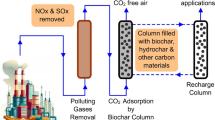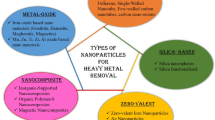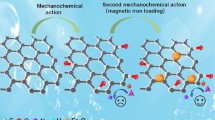Abstract
The removal of Th4+ ions from aqueous solutions was investigated using single-layer graphene oxide (GO) as a sorbent which was prepared by the modified Hummers’ method through batch adsorption experiments at room temperature. Structural characterizations of the sorbent were also investigated. The influences of the pH value of solution, contact time, sorbent dose, ionic strength, the initial metal ion concentration and temperature on the adsorption of Th4+ were also investigated. These results indicated that the adsorption of Th4+ was dependent on the pH and independent on the ionic strength. The sorbent provided significant Th4+ removal (>98.7 %) at pH 3.0 and the adsorption equilibrium was achieved after only 10 min. The Langmuir adsorption isotherm fit the absorption profile very closely, and indicated that a maximum adsorption capacity of 1.77 mmol g−1 of GO (411 mg g−1) after 2 h. The thermodynamic parameters showed that this adsorption process was endothermic and spontaneous. Moreover, the desorption level of Th4+ from GO, by using 0.1 mol L−1 H2SO4 as a stripping agent, was 84.2 ± 1.2 %, and that of 0.5 mol L−1 HNO3 as a stripping agent, was 79.8 ± 3.0 %.












Similar content being viewed by others
References
Humelnicu D, Dinu MV, Drăgan ES (2011) J Hazard Mater 185:447–455
Khazaei Y, Faghihian H, Kamali M (2011) J Radioanal Nucl Chem 289:529–536
Bozkurt SS, Molu ZB, Cavas L, Merdivan M (2011) J Radioanal Nucl Chem 288:867–874
Peters MW, Werner EJ, Scott MJ (2002) Inorg Chem 41:1707–1716
Chen C, Li X, Zhao D, Tan X, Wang X (2007) Colloid Surf A 302:449–454
Anirudhan TS, Suchithra PS, Senan P, Tharun AR (2012) Ind Eng Chem Res 51:4825–4836
Sharma P, Singh G, Tomar R (2009) J Colloid Interface Sci 332:298–308
Humelnicu D, Bulgariu L, Macoveanu M (2010) J Hazard Mater 174:782–787
Anirudhan TS, Sreekumari SS, Jalajamony S (2013) J Environ Radioact 116:141–147
Tan X, Wang X, Fang M, Chen C (2007) Colloid Surf A 296:109–116
Wang YQ, Zhang ZB, Li Q, Liu YH (2012) J Radioanal Nucl Chem 293:519–528
Li D, Müller MB, Gilje S, Kaner RB, Wallace GG (2008) Nat Nanotechnol 3:101–105
Yang ST, Chang Y, Wang H, Liu G, Chen S, Wang Y, Liu Y, Cao A (2010) J Colloid Interface Sci 351:122–127
Zhao G, Ren X, Gao X, Tan X, Li J, Chen C, Huang Y, Wang X (2011) Dalton Trans 40:10945–10952
Zhao G, Li J, Ren X, Chen C, Wang X (2011) Environ Sci Technol 45:10454–10462
Sun Y, Wang Q, Chen C, Tan X, Wang X (2012) Environ Sci Technol 46:6020–6027
Li Z, Chen F, Yuan L, Liu Y, Zhao Y, Chai Z, Shi W (2012) Chem Eng J 210:539–546
Madadrang CJ, Kim HY, Gao G, Wang N, Zhu J, Feng H, Gorring M, Kasner ML, Hou S (2012) ACS Appl Mater Interface 4:1186–1193
Romanchuk AY, Slesarev AS, Kalmykov SN, Kosynkin DV, Tour JM (2013) Phys Chem Chem Phys 15:2321–2327
Liu J, Jeong H, Liu J, Lee K, Park JY, Ahn YH, Lee S (2010) Carbon 48:2282–2289
Chen C, Yang QH, Yang Y, Lv W, Wen Y, Hou PX, Wang M, Cheng HM (2009) Adv Mater 21:3007–3011
Sun L, Yu H, Fugetsu B (2012) J Hazard Mater 203–204:101–110
Xu Y, Bai H, Lu G, Li C, Shi G (2008) J Am Chem Soc 130:5856–5857
Paredes JI, Villar-Rodil S, Martínez-Alonso A, Tascón JMD (2008) Langmuir 24:10560–10564
Mi X, Huang G, Xie W, Wang W, Liu Y, Cao J (2012) Carbon 50:4856–4864
Guo P, Jia X, Duan T, Xu J, Chen H (2010) J Environ Radioact 101:767–772
Özcan A, Öncü EM, Özcan AS (2006) Colloid Surf A 277:90–97
Acknowledgments
This research was financially supported by the International Collaboration Project of Science and Technology Program of Sichuan Province, China (Project no. 2010HH0008), the National Fund for Fostering Talents of Basic Science (J1210004), the Science and Technology Fund of CAEP (2011B0302052) and the National Natural Science Foundations of China (91023037).
Author information
Authors and Affiliations
Corresponding authors
Rights and permissions
About this article
Cite this article
Pan, N., Guan, D., He, T. et al. Removal of Th4+ ions from aqueous solutions by graphene oxide. J Radioanal Nucl Chem 298, 1999–2008 (2013). https://doi.org/10.1007/s10967-013-2660-2
Received:
Published:
Issue Date:
DOI: https://doi.org/10.1007/s10967-013-2660-2




